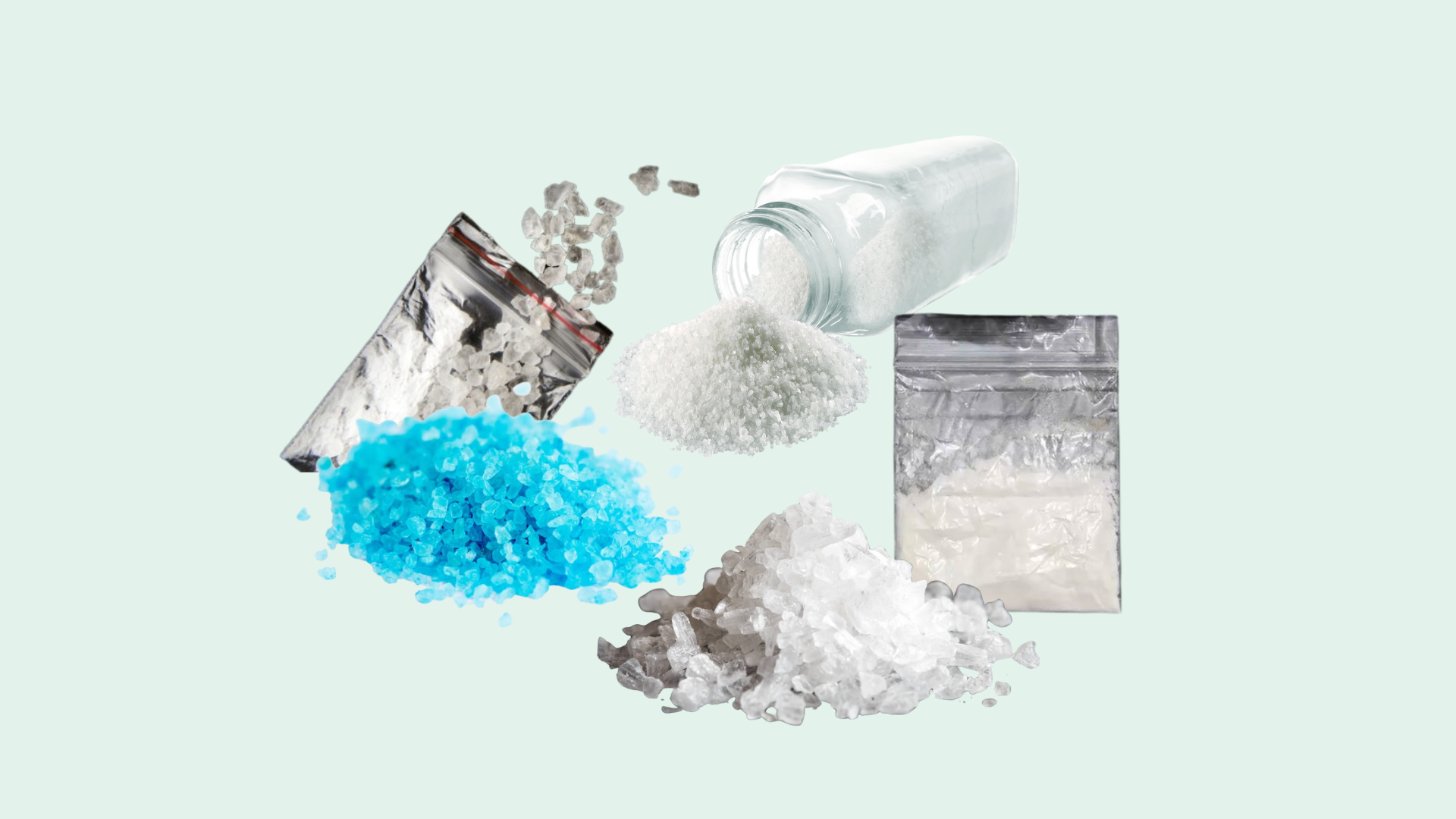What Are Bath Salts?
Bath salts refer to a diverse array of synthetic stimulant drugs that are chemically similar to cathinone, a naturally occurring substance found in the khat plant. Unlike the relatively mild effects of natural cathinone, these synthetic variations can be significantly more potent and have a wide range of dangerous side effects.
The term “bath salts” is somewhat misleading, as these substances are not related to Epsom salts or other genuine bath products. Instead, the name derives from their physical appearance, which often resembles crystalline or powdery bath salts.
Bath salts are also commonly marketed under various other guises, such as
- Phone screen cleaner
- Jewelry cleaner
- Plant food
This is to circumvent legal regulations.
Synthetic cathinones can produce effects similar to those of cocaine, methamphetamine, and MDMA (ecstasy), leading to their widespread abuse as recreational drugs.
How Are Bath Salts Used?
Bath salts can be consumed in various ways, with risks and potential consequences. The most common methods of ingestion include
- Orally: Bath salts can be swallowed as capsules or tablets or dissolved in water and consumed as a liquid.
- Snorting: The powdered form of bath salts can be snorted, leading to a more rapid onset of effects and increased risk of adverse reactions and potential long-term nasal damage.
- Smoking: Bath salts can be smoked, either alone or mixed with other substances, to achieve a quicker high.
- Injection: Some users may dissolve bath salts in water and inject the solution, which carries the highest risk of overdose, vein damage, and the transmission of bloodborne illnesses.
Regardless of the method of use, bath salts’ unpredictable nature makes their consumption inherently dangerous, as the user can never be certain of the exact chemical composition or potency of the substance.
What Are the Effects and Risks of Bath Salts?
Bath salts are classified as stimulants, and their effects on the body and mind can be both intense and unpredictable. Some of the common short-term effects of bath salt use include
- Euphoria
- Increased alertness
- Reduced appetite
- Hallucinations, delusions, and paranoia
- Agitation, aggression, and erratic behavior
However, the use of bath salts can also lead to a range of severe and potentially life-threatening side effects, such as:
- Rapid heart rate and elevated blood pressure
- Hyperthermia and dehydration
- Seizures and stroke
- Kidney damage
- Psychosis and suicidal thoughts
- Muscle breakdown, organ failure, and death
The risk of these adverse effects is further compounded by the fact that bath salts are often combined with other substances, such as alcohol or other drugs, which can amplify their dangerous consequences.
What Is Bath Salts Addiction?
Bath salts, like other stimulant drugs, have the potential to be highly addictive. Repeated use of these substances can lead to the development of a substance use disorder (SUD).
The addictive nature of bath salts is attributed to their ability to alter the brain’s reward and pleasure pathways, leading to a compulsive need to continue using the drug to achieve the desired euphoric effects. Over time, users may develop a tolerance, requiring higher doses to experience the same level of intoxication, ultimately leading to physical and psychological dependence.
What Is Bath Salts Withdrawal and Detox?
Stopping the use of bath salts after prolonged or heavy consumption can lead to the onset of withdrawal symptoms, which can be both unpleasant and potentially dangerous. Some of the commonly reported bath salts withdrawal symptoms include:
- Fatigue and insomnia
- Anxiety and depression
- Paranoia and psychosis
- Tremors and muscle aches
- Nausea and loss of appetite
Withdrawal from bath salts is uncomfortable but not life-threatening. During detox, healthcare providers will closely monitor the individual’s physical and mental wellbeing, providing supportive care and addressing any medical issues.
What Is Bath Salts Addiction Treatment?
Treating bath salts addiction typically involves a multifaceted approach that combines various evidence-based therapies and interventions. The primary goals of treatment are to help the individual achieve and maintain sobriety, address the underlying causes of their addiction, and develop the necessary coping skills and support systems to prevent relapse.
The treatment process often begins with a comprehensive assessment to determine the individual’s needs and develop a personalized treatment plan. This may include
- Detoxification
- Inpatient treatment
- Outpatient treatment
- Behavioral Therapies (such as cognitive behavioral therapy [CBT])
- Medication-assisted treatment
- Aftercare and support services
It’s important to note that the treatment approach may vary depending on the individual’s unique circumstances, the severity of their addiction, and any co-occurring mental health or medical conditions. A comprehensive, personalized treatment plan is essential for achieving the best possible outcomes. Professionals often suggest attending outside support groups as well, such as Narcotics Anonymous (NA).
The addictive potential of bath salts, coupled with their widespread availability and often changing chemical compositions, make them a particularly challenging issue to address. Individuals struggling with bath salts addiction may experience severe withdrawal symptoms and require a multifaceted approach to treatment.
Through increased awareness, effective prevention strategies, and comprehensive treatment options, we can work towards reducing the harmful consequences of bath salts addiction and supporting those in need of recovery.

